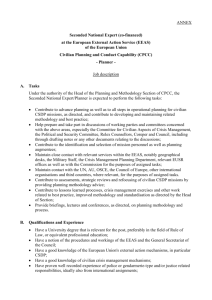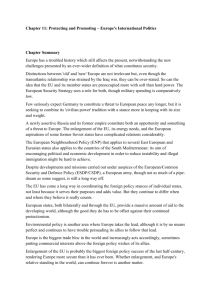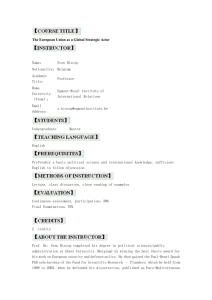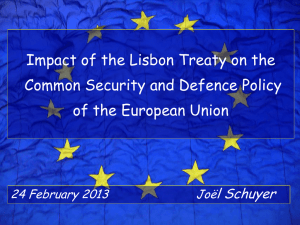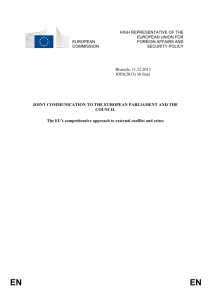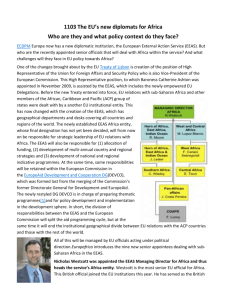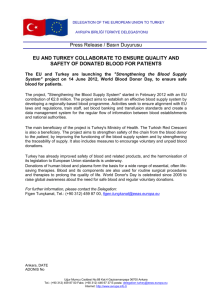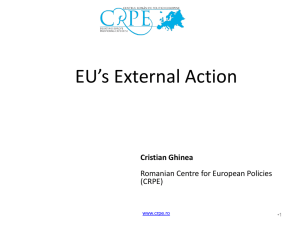EEAS_bureaucracy - Aberdeen University Research Archive
advertisement
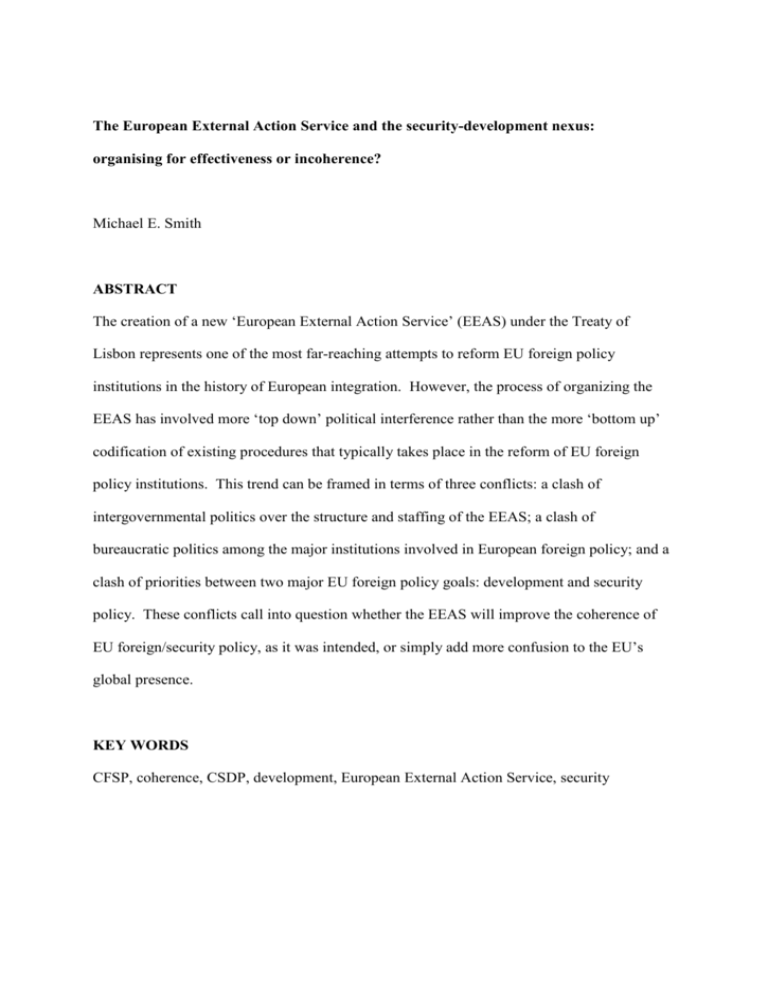
The European External Action Service and the security-development nexus: organising for effectiveness or incoherence? Michael E. Smith ABSTRACT The creation of a new ‘European External Action Service’ (EEAS) under the Treaty of Lisbon represents one of the most far-reaching attempts to reform EU foreign policy institutions in the history of European integration. However, the process of organizing the EEAS has involved more ‘top down’ political interference rather than the more ‘bottom up’ codification of existing procedures that typically takes place in the reform of EU foreign policy institutions. This trend can be framed in terms of three conflicts: a clash of intergovernmental politics over the structure and staffing of the EEAS; a clash of bureaucratic politics among the major institutions involved in European foreign policy; and a clash of priorities between two major EU foreign policy goals: development and security policy. These conflicts call into question whether the EEAS will improve the coherence of EU foreign/security policy, as it was intended, or simply add more confusion to the EU’s global presence. KEY WORDS CFSP, coherence, CSDP, development, European External Action Service, security The Treaty of Lisbon (Lisbon Treaty, or LT) of the European Union (EU) entered into force on 1 December 2009; it amends the 1957 Treaty of Rome and the 1991 Treaty on European Union in a number of important ways, not least in the area of European foreign policy (EFP). Specifically, Title V of the new ‘Consolidated Versions’ of these treatiesi specifies the EU’s new provisions for external action and its Common Foreign and Security Policy (CFSP). Among these provisions, Article 27(3) indicates that a ‘High Representative for Foreign Affairs and Security Policy’ of the EU (HR) shall be assisted by a ‘European External Action Service’ (EEAS). Further, the new EEAS: …(S)hall work in cooperation with the diplomatic services of the (EU) Member States and shall comprise officials from the relevant departments of the General Secretariat of the Council and of the Commission as well as staff seconded from national diplomatic services of the Member States. The organisation and functioning of the European External Action Service shall be established by a decision of the Council. These few sentences, which created an entirely new EU bureaucracy for the conduct of EFP, have provoked a high degree of confusion and conflict within the halls of EU bodies and among the foreign ministries of EU member states. While many of the disputes can be framed most generally in terms of the decades-old controversy between intergovernmental versus supranational visions of how EFP should be governed, the far-reaching nature of the EEAS has inspired several other important, but somewhat less obvious, political disputes about the future of European foreign policy. This issue of the Journal of European Public Policy features a special section of four papers on the EU’s new EEAS-centred foreign policy machinery. Although one can easily 1 claim that the recent problems in the system simply reflect the normal ‘growing pains’ that accompany the development of any new institution, these papers suggest that the challenges facing the EEAS are more deeply-rooted and go well beyond a clash of personalities among senior EFP officials. For example, the paper by Juncos and Pomorska reveals the difficulties involved in staffing the EEAS, while the paper by Wessels and Van Vooren examines how the EEAS creates numerous difficulties for the EU in terms of international law. Agendasetting in EFP also has become more problematic, as the paper by Vanhoonacker and Pomorska demonstrates. Finally, in the rest of this paper I argue that the EEAS, and other EFP-related reforms of the LT, will not only fail to significantly improve the conduct and effectiveness of EFP, they actually represent a step backward in several important ways. This assessment is based on two simple factors, both of which involve the structure of EU institutions that deal with EFP. The first factor involves the LT’s failure to effectively reorganize the EU’s larger foreign policy framework to make a place for the EEAS. As a completely new EFP unit – but not a formal ‘EU institution’ like the European Commission, the European Parliament (EP) or the European Court of Justice (ECJ) - the EEAS would always face an uphill battle to carve out an independent role for itself relative to other important EFP actors (chiefly the Commission). Yet the LT seems to have given no thought to this problem, while maintaining some of the same institutional or structural problems that inspired the idea of an EEAS in the first place. The second problem is internal to the EEAS, and here again the LT did not provide a general blueprint to guide the structure of this new EFP institution. Instead, the process of structuring and staffing the EEAS has been politicized by a range of actors with a stake in the new system (see Juncos and Pomorska 2013)<THIS ISSUE – PUBLISHER TO ADD/UPDATE DETAILS AT PROOF>. Again, some degree of political conflict over these questions is to be expected, but considering the long gestation period of the LT (following 2 from the failed Constitutional Treaty before it) and the expected wide scope of the new EEAS, it is remarkable that the EU did not attempt a far more innovative, and functionally rational, institutional design process.ii These problems, in turn, have had a corresponding negative effect on the ability of EEAS staff members to make the system work more effectively. Specifically, in the rest of this paper I examine the three major political conflicts generated by the creation of the EEAS in hopes of shedding light on the future development and performance of European foreign policy. The first conflict involves the broad intergovernmental negotiations surrounding the overall structure and senior leadership of the EEAS, as the LT was vague on these details. This failing, which is understandable but still surprising considering the potential importance of the new institution, created a major window of opportunity for EU member states to assert their own views about the EEAS structure. This process, in turn, generated a considerable amount of confusion and ill-will among the officials charged with running the EEAS. The second conflict involves more specific, behind-the-scenes bureaucratic disputes within and between the two major institutions involved in EFP: the Commission and the EEAS. These disputes typically take the form of ‘turf battles’ regarding institutional roles, lower-level appointments, and budgets. The third conflict involves disputes over European foreign policy-making, in light of the expansion of the EFP issue-area over the past decade to include a full range of policy problems and policy tools (including police and military forces). The debates surrounding the EEAS, however, have seriously disrupted this process of ‘task expansion’ and ‘tool expansion.’ This problem is most prominent in terms of enhancing policy coordination between two major areas: development and security. Or in other words, between financial/economic policy tools (governed by the Commission) and military/police policy tools (governed by the EEAS). Taken together, then, these three areas of conflict seriously call into question whether the EEAS will improve the coherence of EU 3 foreign/security policy, as it was intended, or simply add more confusion and inefficiency to the EU’s global presence. WHY AN EXTERNAL ACTION SERVICE? The creation of the EEAS continues a long tradition of institutional reform in EFP extending back to the creation of European Political Cooperation (EPC) in 1970. Since then, the EU has developed an increasingly complex institutional infrastructure to devise and implement its various foreign/security policies. Moreover, most institutional reforms in EFP, beginning with changes to EPC during the 1970s-80s and followed by the transition from EPC to the CFSP after 1993, have involved the codification of informal procedures that developed out of actual practice. In other words, there has always been a strong ‘bottom-up’ dynamic of institutional reform whereby EFP elite practitioners develop new working procedures in response to problems they encounter in their work; these procedures are then codified in formal treaty documents (Nuttall 1992; Smith 2003). With this approach to institutional reform, the supply of most new EFP rules is largely determined by the demand for such rules generated by lower-level EFP practitioners. A functional-instrumental logic of change (March and Olsen 1984) prevails, largely driven by pragmatic needs encountered in the daily business of making European foreign policy. The EEAS, conversely, is a far more ‘top down’ solution driven by the negotiators of the LT and the intergovernmental political bargains (Moravcsik 1993) that accompanied the early stages of its implementation. This point can be appreciated more clearly by examining the extent to which the LT actually changed the institutional machinery of EFP in order to improve the EU’s standing as a global actor. The most general ‘reform’ here is the supposed new focus on EU ‘external action’ rather than the maintenance of a distinction between ‘external relations’ (i.e., the ‘low politics’ of trade and development) and ‘foreign/security 4 policy’ (i.e., the ‘high politics’ of the CFSP and the Common Security and Defence Policy, or CSDPiii). To help facilitate this change in terminology, a new Chapter 1 under Title V brings together a wide range of general principles (democracy, human rights, and the rule of law) and specific goals (conflict prevention, trade liberalization, and sustainable development) to be served by the EU’s external action policies. However, most of these goals were already part of existing EU/EC treaties; moreover, the LT maintains the ‘specific rules and procedures’ that govern the CFSP/CSDP as opposed to all other EU foreign policies. These include a limited role for the Commission and EP, as well as the long-standing exclusion of the ECJ from adjudicating nearly all decisions and actions taken under the CFSP/CSDP (Title V, Art. 24). In other words, this is ‘business as usual’ regarding the specific roles of the EU’s most important supranational institutions: the Commission, the EP, and the ECJ.iv Other marginal changes to the conduct of EFP include changes to the role of the HR, the removal of the CFSP ‘common strategies’ instrument (which had never developed as expected), and the creation of ‘legal personality’ for the EU, which allows the EU to negotiate and sign international agreements and join international organizations.v No major decision-making innovations were introduced beyond those already in place, which means that unanimity still governs all key CFSP/CSDP decisions. Mechanisms for ‘enhanced cooperation’ (Title IV) and ‘constructive abstention’ (Title V, Art. 31), which theoretically allow for ‘coalitions of the willing’ to take certain foreign policy decisions, remain in the treaties, yet the EU has always been reluctant to take such decisions on the basis of anything other than consensus/unanimity (although not all EU member states have to participate in a CFSP/CSDP mission). Similarly, no EU institution has a monopoly on CFSP agenda-setting, as questions or proposals/initiatives regarding the CFSP may come from any EU member state, the HR alone, or the HR with the support of the Commission (Title V, Art. 30[1]). The 5 Political and Security Committee (PSC) also has the right to give opinions on policy initiatives regarding the CFSP (Title V, Art. 38). The most significant EFP-related reform, therefore, is the creation of the EEAS itself. Unlike the situation prior to the LT, the HR now serves as a formal institutional linkage for EFP matters between the Council of the EU (the HR as the ‘general manager’ of CFSP/CSDP affairs) and the Commission (the HR as a Commission Vice President). However, while the HR was originally viewed by some Constitutional/Lisbon Treaty architects as a ‘foreign minister’ of the EU, that view has diminished considerably. And although the HR is supposed to replace the holder of the rotating EU Presidency as the main driver of CFSP/CSDP affairs (Title V, Art. 18), he/she still must compete with the new position of the President of the European Council, who is charged with ensuring the ‘external representation’ of the Union on issues concerning the CFSP (Title III, Art. 15[6]), as well as the Commission President, who still retains considerable authority over most economic-related aspects of EFP and ‘ensures the EU’s external representation’ over non-CFSP foreign affairs matters (Title III, Art. 17).vi These two ‘presidential’ EU actors, further, hold a higher diplomatic status relative to the HR (as full members of the European Councilvii); therefore they can easily usurp the HR’s authority in day-to-day decision-making. They are also charged with ensuring the overall consistency of the EU’s external actions and other policies (Title V, Art. 21[3]).viii These provisions clearly confuse the nature the practical working relationship between the President of the European Council, the President of the Commission, the HR, and top government officials of EU member states (particularly the holder of the six-month rotating EU Presidency, which remains as an institution). The fact that the CFSP is supposed to be ‘put into effect’ by the HR and the member states, using both national and EU resources, only adds to the confusion (Title V, Art. 26[3]). There is similar confusion 6 regarding crisis procedures and EFP: the President of the European Council – not the HR has the authority to convene ‘extraordinary meetings’ of the European Council ‘if international developments’ require (i.e., a crisis). These meetings can attempt to define the ‘strategic lines’ of the EU’s policy in such a situation (Title V, Art. 26[1]), yet the HR can also request an extraordinary Council of the EU meeting within 48 hours (or less) ‘in cases requiring a rapid decision’ (Title V, Art. 30[2]). As a result of these shared responsibilities, then, the only tangible sources of ‘uniquely HR-owned’ institutional power under the LT would be: 1) the HR’s chairmanship of Foreign Affairs Council meetings (Title III, Art. 18; Title V, Art. 27[1]); 2) his/her ability to appoint ‘special representatives’ (Title V, Art. 33); and 3) his/her ‘ownership’ of the EEAS network (Title V, Art. 27[3]). Critically, the rotating EU Presidency still chairs all other Council meetings (such as Development), which, in addition to other factors noted below, obviously limits the HR’s ability to improve the links between development and security policy. In short, rather than clarify who represents the EU’s ultimate ‘face’ or ‘voice’ in world politics, the LT has only made the situation more confusing than ever before, with at least four actors (rather than three, prior to the LT) who now claim some authority to speak on behalf of the EU: the President of the European Council, the President of the Commission, the holder of the rotating EU Presidency, and the HR. This is also the disorderly new structure in which the EEAS is supposed to function. INTERGOVERNMENTAL POLITICS AND THE EEAS The provisions noted above took years to develop, and implementation of the LT was further delayed throughout 2009 during a difficult ratification process. These delays in general, and the lack of details about the structure and leadership of the EEAS in particular, created a major window of opportunity for intergovernmental disputes about EFP. The first 7 clear indication of trouble was the limited professional background of the new HR, Catherine Ashton, and the public disputes and deal-making surrounding her appointment and that of the new President of the European Council, Herman Van Rompuy. Ashton lacks the foreign/security policy experience and stature of the previous holder of the HR position (Javier Solana), and her appointment was received by EFP insiders, as well as other informed commentators, with surprise at best and dismay at worst. To a large extent, these views have not changed since she was appointed; in fact, several senior EEAS insiders with decades of EFP experience have claimed that the management style in the new EFP framework, starting with Ashton’s decision-making style and cabinet appointments and extending downwards into the EEAS machinery, is the worst they have ever experienced (interviews, 2010-12; also see Juncos and Pomorska 2013)<THIS ISSUE – PUBLISHER TO ADD/UPDATE DETAILS AT PROOF>. These top appointments were quickly followed by intensive negotiations among EU governments over other important decisions, particularly regarding the EEAS structure. As with most EU treaties, the details were left to be decided at a later date, and Ashton as HR was charged with proposing the structure and staffing of the new EEAS, one of the most wide-ranging institutional changes ever attempted in the EU given its impact on EU member states, on the Council of the EU, and on the Commission. Ashton’s proposals underwent several permutations throughout 2010 whose details can only be touched upon here.ix For example, questions regarding staff rotations, conditions of employment, training, pensions, security clearances, legal dimensions, and similar topics required detailed negotiations, and cannot be dealt with at length here (see the other contributions to this special section of papers). Instead, I focus on the more general and higher-profile problems regarding the EEAS. 8 The key point is that, beyond the general agreement on staffing the EEAS from various institutional sources at the EU and national levels, things quickly grew more complicated as EU policy elites realised the full implications involving in creating the EEAS. In fact, EU legal officials in various bodies admitted later that they had no idea how the EEAS was supposed to be structured and staffed, or even how it was supposed to function. In their view, there was a distinct lack of intellectual preparation regarding these basic questions, plus some degree of ‘treaty fatigue’ following the troubled Lisbon ratification process. Several other senior EFP officials in the Commission confessed that everyone in the EU underestimated the scope of the task, while an EU member state PSC representative admitted that ‘no one expected Lisbon to be so difficult’ (interviews, 2010-12). EU member state governments, however, had their own ideas about these issues, and they began to assert themselves in the process from the very start. The most important player was France, which had pushed successfully to create a kind of ‘hybrid’ of two main EFP units in the Council General Secretariat: DG-8 (defence/military affairs) and DG-9 (civilian crisis management, which included the Civilian Planning and Conduct Capability unit, or CPCC). This new ‘hybrid’ began in the form of the Crisis Management Planning Directorate (CMPD), which was supposed to play a central role in the new EEAS, although the French initially resisted the inclusion of the CMPD in the EEAS, preferring to keep it in the Council General Secretariat. Following ratification of the LT, and in a deal with Finland, France won a critical appointment in the form of the new head of the CMPD, Claude-France Arnould, a French national (and the former head of DG-8 for defence).x This change provoked a great deal of conflict within the Council and with related actors in other bodies: the Commission and the EP. Two major concerns were that the highly-experienced former head of the CPCC, Mika-Markus Leinonen, was effectively demoted in favour of Arnould, and that about four- 9 fifths of the CMPD staff had military rather than civilian backgrounds. This structure and leadership effectively undermined the EU’s knowledge base of civilian crisis response even though most CSDP operations have in fact been civilian rather than military in nature (see below). However, within a year of the LT entering into effect, Ashton moved Arnould from the CMPDxi to the leadership of the European Defence Agency (EDA).xii Ashton then downgraded the CMPD itself in light of her new priorities for the EEAS as an institution (see below).xiii France made a second key deal with Germany: France would appoint the new Secretary General of Council (Pierre de Boissieu) while Germany would appoint the new holder of the role of EEAS Deputy Secretary General for Political Affairs (Helga Schmid), which is the key policy-making position in that body (next to Ashton’s role). Compounding this problem is the more general fact – admitted by multiple EFP officials in various EU bodies and the PSC - that Ashton has an ‘impossible’ set of responsibilities, especially in terms of moderating the positions of powerful EU member state governments and balancing the Commission-Council division of labour (interviews, 200912). In fact, she has more responsibilities – but less experience and a much weaker reputation – than Solana ever had. These include acting as Vice President of the Commission (which provoked other problems; see below); creating/running the EEAS; chairing meetings of the Foreign Affairs Council (FAC) of the EU; acting as the external face of the EU or as a lead negotiator; and managing EU special representatives in various states/regions, among other things. The FAC role in particular will be time-consuming; Ashton was scheduled to attend 46 such ministerial meetings in her very first semester on the job. Solana, conversely, rarely attended such meetings. Given this range of responsibilities, and the HR’s competition from other officials noted above (and discussed below), it is still all too easy for an assertive EU member state to undermine her position.xiv Smaller EU member states, in fact, are already worried about 10 these trends (and others; see below). They are especially wary about the future role of ‘permanent structured cooperation’ in EFP affairs, as this method could easily allow a directoire of more powerful EU member states to set the EFP agenda (interviews, 2009-12). The EP also wants more details about, and oversight of, the EEAS in general and permanent structured cooperation in particular, yet the LT does not allow this, at least not formally.xv A related intergovernmental problem involves the CSDP capacity. As the CSDP can involve the projection of military power, there is a clear need for a permanent European Operational Headquarters (OHQ) for running CSDP missions rather than relying on an EU member state to offer its own OHQxvi or relying on NATO’s OHQ at SHAPExvii under the ‘Berlin Plus’ arrangement. The EU does have, since 2007, its own small OHQ in Brussels to run missions of a limited size (around 2,000 personnel), but this has not been used to run an actual CSDP mission. Instead, each CSDP mission requires negotiations among EU member states about which OHQ will be used; EU member states that volunteer their OHQs for a mission must also agree to provide additional resources in case Brussels fails to do so (the ‘costs lie where they fall’ principle). In a similar manner, the EU’s ‘Battlegroup concept’ has not developed as hoped; it has become more of a capacity-building mechanism rather than a permanently-available rapid reaction force, as it was intended.xviii Despite several opportunities to deploy standing EU Battlegroups on actual CSDP missions, various EU member states have opposed this approach in favour of organizing missions on a case-bybase basis. This tendency, in turn, creates delays and confusion as all of the operational details must be worked out among the EU member states that agree, in principle, to participate in the mission. BUREAUCRATIC POLITICS AND THE EEAS 11 These top-level problems, which have only been touched upon here, have also exacerbated processes of bureaucratic politics among and within key EU organizations, particularly the Council of the EU, the EU Military Staff (EUMS), the Commission, and to a lesser extent, the EP. Obviously there is some degree of overlap between intergovernmental and bureaucratic politics; however, bureaucratic political disputes regarding EFP and the EEAS generally involve middle-level turf battles among EU organizations sharing similar responsibilities owing to the highly fragmented nature of EU policy-making (Peters 1992). In addition, bureaucratic disputes do not normally attract the attention of senior government officials of EU member states (i.e., heads of government or foreign ministers), and they tend to be resolved by claims of competence and specific reference to EU legal rules and soft law (including the possibility of adjudication by the ECJ) rather than by intergovernmental dealmaking. Thanks to a combination of intergovernmental and bureaucratic politics, then, it took months of public controversy throughout 2010 for Ashton’s final proposal for the structure and staffing of the EEAS to be approved by the EP on 20 October,xix so that the EEAS could come into existence on 1 December 2010.xx Since then, there have been no major innovations in the EEAS structure but only continued disputes about how it is supposed to work. As more than one EEAS insider put it, there has been ‘progress on paper’ in the form of regular new ‘organigrammes’ describing the EEAS structure, but little progress in reality (interviews, 2010-12). For example, the system of organizing the EEAS under a series of seven ‘Managing Directors’, primarily along geographic lines, was largely taken from the Commission’s own organizational structure.xxi However, these seven ‘new’ units are still bureaucratically distinct from the three already-existing important units (the EUMS, CPCC, and the CMPD) from the Council that had controlled the bulk of CFSP/CSDP affairs. This arrangement has 12 effectively institutionalized a division between the Commission-dominated geographic units and the Council-dominated CFSP/CSDP/crisis units. Problems here are too numerous to mention in detail; the key point is that EU insiders across the system can cite various examples of how petty disputes, or simple confusion, about institutional procedures or roles interfere with the smooth planning and execution of CFSP/CSDP operations. In addition, the reluctance of some EU member states, as noted above, to permit a more effective and better-resourced OHQ in Brussels compounds a bureaucratic problem: the need for greater civil-military coordination in EFP, particularly CSDP missions. Despite the expansion of CSDP tasks since 2003, there is still some degree of suspicion between the civilian and military parts of the structure. This occurs not just between bodies such as the Commission and EUMS, but even within the Council of the EU and the EEAS (which now includes the EUMS, even though the EUMS is in a different building at the time of writing). For example, the ‘Civ-Mil Cell’ organized by the EUMS to improve civilian-military coordination in the CSDP did not work as desired and resulted in the creation of a redundant planning/coordination system in the General Secretariat of Council (a system which eventually became the CMPD). However, several CSDP officials later confessed that they had no clue as to the function of the Civ-Mil Cell, nor which bureaucratic master (i.e., the Commission or the Council of the EU) it was supposed to serve. One member of the Cell also admitted that it was not getting the ‘tasking’ it had expected, possibly because it was located in the EUMS rather than in the Council/EEAS more generally (interviews, 20072011). The creation of a ‘Situation Centre’ within the CSDP infrastructure also undermined the need for a Civ-Mil Cell, as both bodies attempted to claim some authority over CSDP analysis and – crucially – operational planning. The Situation Centre also has taken the lead over risk assessment, which is an integral part of the planning process. As a result, the EU 13 has never actually mounted a truly joint civilian-military operation (i.e., one with a single chain of command covering both civilian and military components), although it has conducted simultaneous civilian and military operations in a single foreign country. The LT intensifies these civilian-military disputes by retaining two separate funding lines (and therefore two decision-making procedures): 1) the Athena facilityxxii along with a new ‘start up fund’ for military operations; and 2) the Instrument For Stability (IFS)xxiii for civilian operations. These mechanisms are in addition to the ‘normal’ CFSP and External Relations budget lines that already exist in the EU, controlled by the Commission. The question of controlling the EU’s 9.5 billion euro annual external relations budget has also been complicated by bureaucratic politics. The Commission retains full control of several important foreign policy instruments (such as humanitarian aid, European Neighbourhood Policy, and development funding, among others, which account for 7.5 billion euro a year), as Ashton was not able to consolidate these lines under her authority. The Commission also gained the right in 2011 to create a new ‘Service for Foreign Policy Instruments,’ which is the only Commission unit actually housed in the EEAS. It has the right to approve Commission-controlled foreign policy funds, such as the IFS, EU-funded CFSP operations, and elections observation missions; it also controls the press and communications budget of the EEAS itself. Finally, the Commission shares control of the European Instrument for Democracy and Human Rights with the EEAS, under a recent (2012) inter-service agreement.xxiv Since the LT entered into effect, then, the Commission (with support by the EP) has asserted its legal authority over budgetary matters to retain control of various EFP responsibilities (particularly development policy), and it has attempted to maintain control CSDP rule of law missions against the wishes of the Council. The result of these efforts is that the Commission still controls a great deal of EFP planning/budgeting, equipment, and 14 financing, while the EEAS/CFSP/CSDP system actually conducts foreign/security policy actions. The Commission also still sees the EEAS/CFSP/CSDP as a threat to its bureaucratic interests, while some EU member states have reinforced this view by attempting to exclude the Commission from a role in CFSP/CSDP operations, especially military ones (interviews, 2007-12). THE SECURITY-DEVELOPMENT NEXUS Intergovernmental disputes over structure/leadership, and bureaucratic disputes over turf/budgets are not the only problems with the LT in general and the EEAS in particular. As the LT did not add more coherence to EFP priorities, and as the EEAS structure has been devised primarily according to political rather than functional considerations, the EFP agenda has suffered accordingly (see Vanhoonacker and Pomorska 2013)<THIS ISSUE – PUBLISHER TO ADD/UPDATE DETAILS AT PROOF>. In the most general terms, the LT and the EEAS have institutionalized, rather than eliminated, a division between the EU’s development cooperation agenda (dominated by civilian instruments and the Commission) and the security policy agenda (dominated by the EEAS/EU member states with recourse to military/policing instruments). The LT did not radically alter this division of labour, even though Ashton did attempt, briefly and unsuccessfully, to gain more control over some areas of Commission competency. This clash even led the Commission to take the Council to court regarding a CFSP mission to control small arms in Chad. The Commission successfully argued that the CFSP mandate had mentioned ‘socio-economic stability’ as just one of the goals of the policy, which is a Commission competency. The practical result of these budgetary and turf battles is that the EU now has two formal ‘executive bodies’ for conducting EFP: the Commission (for trade, development, and humanitarian aid) and the EEAS (for CFSP/CSDP). Both 15 institutions also share responsibility for general ‘crisis management’, which cannot possibly add to the EU’s overall effectiveness as a global actor, as the LT had intended, even though Ashton later created a ‘Crisis Management Board’ and a ‘Crisis Platform’ in the EEAS to help coordinate this policy area.xxv The fact that the EEAS itself has had to devise these new internal coordination mechanisms – in addition to already-existing ones (the CPCC and the CMPD) - clearly indicates that its structure did not solve the coordination problems EFP already faced prior to the LT; it merely re-packaged them into a new bureaucracy. These policy conflicts over security, development, and crisis management objectives have been exacerbated by a related one: a clash between the ‘humanitarian assistance’ agenda (involving ECHO, the European Community Humanitarian Office, and its Aid and Civil Protection arm, controlled by the Commission) and the ‘emergency/disaster response’ agenda (represented by a new EEAS Managing Director for Crisis Response and Operational Coordination, Dr Agostino Miozzo). Dr Miozzo, an Italian physician with years of disaster management and emergency relief experience, was appointed by Ashton (and in defiance of the wishes of some EU member states) after she personally saw him in action during the Haitian earthquake relief effort. In fact, the position of EEAS Managing Director for Crisis Response and Operational Coordination was created by Ashton so that Miozzo could hold it. He also reports directly (as a Managing Director) to Ashton herself rather than through other EEAS bodies that would, in the past, have dealt with crisis management tasks (such as the CPCC or the CMPD). This appointment, which directly challenged the French view of the EEAS structure, not only created confusion within the EEAS, it also provoked controversy with the Commission ECHO unit. In other words, beyond a simple ‘turf battle’ between EU bodies we can also see a dispute between the short-term emergency relief agenda (represented by Dr Miozzo in the EEAS) and the longer-term humanitarian aid/development agenda (represented by the Commission)(interviews, 2011). 16 Ultimately, then, the appointment of Ashton, the creation of the EEAS, and the new structure of the CMPD cannot prevent these civilian-military, and Commission-EEAS, disputes from undermining the conduct of EFP in general and the CFSP/CSDP in particular. And although Ashton as HR is authorized to manage (within the new EEAS) various crisismanagement and defence-related EU bodies - the EUMS, the EDA, the EU Satellite Centre, the EU Institute for Security Studies, and the European Security and Defence College – it is still unclear how much authority she will actually have over these bodies with regards to planning and executing CFSP/CSDP missions.xxvi EEAS insiders also note that Ashton spends most of her time travelling outside the EU (250 days a year on average), and therefore does not have the time or inclination to deal with bureaucratic problems and long-term planning in the EEAS, which then undermines morale among those who must work within it (interviews, 2011). Based on the development of the EEAS since 2010, the signs do not look promising. The most obvious evidence of this fact is that the EU ceased undertaking new CSDP missions once it became clear that Lisbon was going to be implemented along with its new EEAS. This lack of new CSDP missions was not a result of the lack of opportunities. For example, the EU has played virtually no role whatsoever in the democratic protests that have spread throughout the Middle East since January 2011, even though the EU can claim decades of positive involvement in the region. The EU did agree to support the reforms in Libya with a decision in April 2011 to provide military assistance to deliver humanitarian aid, if specifically requested by the UN. However, this request never came, so the CSDP mission (EUFOR Libya) was never launched. And beyond this reluctance to allow the system to work as intended when EU member states lack full consensus on an issue (as with the Libyan intervention), there is still a general resistance among some EU member states to the idea of 17 giving Ashton and the EEAS more independent authority in any crisis-type situation, whether it involves disaster relief or conflict resolution/prevention (interviews, 2011). These factors, it seems, have now produced a kind of ‘holding pattern’ for the EFP while the bugs are worked out of the new system, and may take at least another year or two (or more) to start working more effectively, unless major reforms are made. However, the major structural problems in EFP remain (i.e., multiple ‘voices’ for EFP, insisting on consensus, no consistent source for agenda-setting, a lack of resources, etc.), so that the EEAS is unlikely to become the central locus of authority in this policy domain despite the promises made in the LT. As we have seen, there have been, and will be, no shortage of opportunities for the HR, the European Council, the Council of the EU, the Commission, and EU member states to clash over the formation and conduct of European foreign policy. These conflicts, and the more general relationship of the EEAS to other EU bodies, call into question whether the EEAS will improve the coherence of EU foreign/security policy, as it was intended, or will simply add more confusion and inefficiency to the EU’s global presence. CONCLUSION The fact that the EU has developed such a wide range of EFP competences, up to and including the use of policing/military forces, is a major achievement for a regional international organization, especially one with such a diversity of interests and power resources among its 27 member states. This achievement has been realized through a combination of formal intergovernmental treaty reforms and, equally importantly, informal socialization processes and customary working procedures. In fact, it could be argued that there has been more dynamism and institutional innovation in this domain than in any other EU policy area in the past decade. Moreover, various EU insiders across the system 18 consistently report their support for enhancing the EU’s standing as a global actor; they also clearly believe that the EU can bring a unique capability – or ‘comprehensive approach’ (Smith 2012) - to contemporary security and development problems (interviews, 2007-11; also see Juncos and Pomorska 2013)<THIS ISSUE – PUBLISHER TO ADD/UPDATE DETAILS AT PROOF>. However, when compared to other EU policy domains, there is still a high degree of uncertainty and inconsistency regarding how – or even if - the EU will respond to a major crisis or other foreign policy problem. Formal treaty reforms to EFP may have reached their limit, as there is no agreement among EU member states to ‘Europeanize’ the CFSP/CSDP any more than has already occurred, especially if one measures Europeanization primarily in terms of policy delegation to a supranational body (the Commission), the regular use of some form of majority voting within the Council, greater oversight by the EP, and periodic reliance on the ECJ to resolve disputes over compliance and other problems (Smith 2012). EU member states are unlikely to pursue any of these options when reforming EFP decisionmaking procedures in the near future, so EU policy elites will have to resort to other consensus-building mechanisms, such as networking, socialization, and learning, for the foreseeable future. Informal social methods have a long and interesting history in EFP and efforts to reform EU treaties should attempt to respect this fact. Unfortunately, the drive to negotiate and implement the LT has seriously disrupted these social processes in numerous ways, not the least of which is the ‘top-down’ and illconsidered construction of the EEAS and the question of its working relationship with other EU bodies. The key point here is that the LT created a major new EFP institution without seriously re-examining, or reforming, the broader institutional context in which the EEAS must operate, and without seriously considering the structure and leadership of the EEAS itself. There has also been no major attempt to institute a comprehensive training programme 19 to create a solid esprit de corps among new EEAS staff members, as one would expect to find in any modern diplomatic service.xxvii To a large extent, then, the EU has attempted to ‘muddle through’ these problems by improvisation and negotiation, and has allowed political considerations to take precedence over the functional needs of the new institution. Obviously the EEAS does not operate in a political vacuum, and it does reflect larger political problems in the EU over the priorities of EFP (such as the euro-zone crisis of 2011-12). However, the EEAS also was specifically created to help extend EFP despite such problems, and clearly that does not seem to be happening so far. Instead, we see continued disputes over several critical EFP issues: adequate resources for CFSP/CSDP missions; the use of Battlegroups for CSDP missions (which has yet to occur); who ultimately speaks for the EU in foreign affairs; improving coherence between, and command of, civilian and military EFP instruments and the securitydevelopment nexus; general lines of authority over various EFP competences; excessive duplication of EFP responsibilities among EU bodies; and the ongoing question of developing a stronger OHQ in Brussels to oversee CSDP operations (among other problems). Finally, and somewhat ironically, perhaps, the EU was in fact managing to deal with some of these problems, particularly the security-development nexus, in an informal fashion prior to the LT. This can be seen most prominently in the EU’s development of the CSDP. The EU had in fact launched over twenty CSDP missions of various types before the ‘reforms’ of the LT were even implemented (Smith 2012). In one of the most important of these missions, Operation Atalanta, the EUMS and the Commission worked together to devise a legal framework for enabling captured pirates to submit to criminal prosecution. As this mission is primarily intended to protect the EU’s trade interests, it serves an important security function for Europe, indicating that the operation goes well beyond the traditional Petersberg-type CSDP tasks that originally helped to justify an independent EU military 20 capability in the 1990s (Germond and Smith 2009).xxviii Yet this civil-military, and securitydevelopment, coordination was not a product of the EEAS system, so the EEAS ‘reforms’ were not at all necessary to achieve it. As the EU has not attempted a major CSDP operation since the LT entered into effect, it remains to be seen whether the reforms of the LT, centering on role of the HR and the EEAS, will enable the EU to live up to its global political ambitions. The early signs, however, are not very encouraging. Biographical note: Michael E. Smith is Professor of International Relations in the Department of Politics and International Relations, University of Aberdeen, Scotland. Address for correspondence: Michael E. Smith, Department of International Relations, Edward Wright Building, University of Aberdeen, Aberdeen, AB24 3QY, UK. email: m.e.smith@abdn.ac.uk. ACKNOWLEDGMENTS I would like to acknowledge the generous financial support of the European Research Council (Grant No. 203613) for funding my research in EU foreign/security policy institutions. I would also like to thank the many senior officials who granted personal interviews with the author, on a confidential basis, on more than fifty occasions between 2007-12. These officials were based in the General Secretariat of the Council of the EU, the European Commission, the European External Action Service, the EU Military Staff, the European Parliament, and the permanent representations of various EU member states. NOTES 21 i The consolidated version includes the amendments of the LT, and all subsequent references to specific treaty articles in this paper are taken from this version rather from the LT alone. See the Council of the Union document 6655/08 (14 April 2008). ii For more on rational institutional design, see Koremenos, Lipson, and Snidal 2001. iii Prior to the Lisbon Treaty, the CSDP was known as the European Security and Defence Policy. For the sake of consistency I use the term CSDP throughout this paper. iv For more details on these provisions, see Whitman 2008. v The European Community already had legal personality prior to the LT reforms. vi The Commission President may also ask the HR to resign (Title III, Art. 17[6]). vii Although the HR is permitted to take part in the work of the European Council. viii Though the HR is supposed to assist the European Council President and the Commission President with this task. ix Other actors within the EU submitted their own views on the structure and staffing of the EEAS, so that by early 2010 there were over half a dozen such ‘non-papers’ in circulation among EFP elites. In many cases, it was not clear who had even authored the papers (interviews, 2010-11). x The CMPD is more correctly known by its French name, the Direction Gestion de Crises et Planification. xi According to EEAS insiders, Arnould’s abrupt departure as head of the CMPD was a result of two factors: her personal clashes with Ashton, and her weak management skills within the CMPD unit. For example, during Arnould’s brief time as CMPD head, five lawsuits were filed against her by CMPD employees (interviews, 2011). xii Walter Stevens of Belgium became head of the CMPD in April 2011. xiii In fact, several Members of the EP sent an official letter to Ashton to complain about this development, yet it had no impact. Among other things, the Members said that the 22 new CMPD structure would lose the conflict resolution and peacekeeping/prevention capacities that had been built up in DG-9 over the past several years. xiv Ashton did propose that she should be allowed to appoint a secretary-general to handle the day-to-day business of the EEAS. This idea, however, provoked criticism by the EP as the secretary-general would be less accountable to it than Ashton herself. Ashton later retracted the idea in favour of a collegial leadership of three officials: herself, an Executive Secretary General (Pierre Vimont) and a Chief Operating Officer (David O’Sullivan). xv The EP does have the authority to approve the budget of the EEAS, and it succesfully threatened to use this power to gain more control over EEAS appointments and related issues. xvi Specifically, the French OHQ in Mont Valérien, Paris; the UK OHQ in Northwood; the German OHQ in Potsdam, Berlin; the Italian OHQ in Rome; and the Greek OHQ in Larissa. xvii Supreme Headquarters Allied Powers Europe, in Mons, Belgium. xviii An EU Battlegroup is a form of rapid-response capacity-building, each one consisting of around 1,500 troops reinforced with combat support elements, including relevant air and naval capabilities, which can be launched on the ground within ten days after the EU decides to act. xix The Commission, along with representatives of EU member states and the Council General Secretariat, also sits on the new Consultative Committee on Appointment, which chooses senior appointments to the EEAS. See the HR’s “Draft Council Decision Establishing the Organisation and xx Functioning of the European External Action Service,” 25 March 2010 (Council of the EU, Brussels), doc. 8029/10. This document, however, contained various provisions indicating that important powers of the HR/EEAS will be subject to further review (or to be determined) 23 once the EEAS assumed its operations. Already in 2011 there was talk among EEAS insiders that the structure would need to be changed (interviews, 2011). xxi Crisis Response; Asia/Pacific; Africa; Europe/Central Asia; North Africa/Arabian Peninsula/Iran/Iraq; Americas; and Global and Multilateral Issues. An eighth Managing Director handles administration and finance in the EEAS. xxii As the EU budget cannot be used to fund military operations, the Athena facility (codified in Council decision 2004/197/CFSP on 1 March 2004) provides for a common pool of financial and other resources supplied by, and drawn upon, EU member states participating in a CSDP military operation. xxiii Unlike the Athena mechanism, which involves intergovernmental contributions, the IFS is a Community budget line that helps to speed up the disbursement of funds controlled by the Commission in situations involving crisis management, conflict resolution, and peacebuilding. “Commission Still Pulls the Strings on EU Foreign Policy,” EU Observer, 6 xxiv February 2012. This view is supported by another simple but overlooked fact: the EU’s former xxv Commission Representations to third countries and international organisations were changed into broader EU Delegations after the LT. These EU Delegations are supposed to be under the authority of Ashton through the EEAS, yet the Commission can still issue its own instructions to Delegation staff (as well as maintain its own non-EEAS staff members) in the areas for which it claims competency (mainly trade and development policy). The politics of staffing these delegations is considered a ’secret mess’ according to EEAS insiders (interviews, 2011). 24 xxvi Also note that Ashton does not have an official portfolio as a Vice President of the Commission, nor is she on the official Vice President rotation among other Commissioners who hold a Vice-Presidential role. xxvii For more on this point, from a practitioner’s point of view, see Spence 2012. xxviii Petersberg tasks consist of humanitarian or rescue operations, peace operations, and combat missions for crisis resolution, including peacemaking operations. They were defined in 1992 by the Western European Union and later incorporated into EU treaties. REFERENCES Germond, B., and Smith, M.E. (2009) ‘Re-thinking European security interests and the ESDP: Explaining the EU’s anti-piracy operation’, Contemporary Security Policy 30(3): 573-93. Juncos, A.E., and Pomorska, K. (2013) ‘“In the face of adversity”: explaining the attitudes of EEAS officials vis-à-vis the new system’, Journal of European Public Policy <THIS ISSUE – PUBLISHER TO ADD/UPDATE DETAILS AT PROOF>. Koremenos, B., Lipson, C., and Snidal, D. (2001) ‘The rational design of international institutions’, International Organization 55(4): 761-99. March, J.G., and Olsen, J.P. (1984) ‘The new institutionalism: organizational factors in political life’, American Political Science Review 78(3): 734-49. 25 Moravcsik, A. (1993) ‘Preferences and power in the European Community: a liberal intergovernmentalist approach’, Journal of Common Market Studies 31(4): 473524. Nuttall, S.J. (1992) European Political Cooperation, Oxford: Clarendon Press. Peters, B.G. (1992) ‘Bureaucratic politics and the institutions of the European Community’, in A. Sbragia (ed), Euro-Politics: Institutions and Policy-Making in the ‘New’ European Community, Washington: Brookings Institution. Smith, M.E. (2003) Europe’s Foreign and Security Policy: The Institutionalization of Cooperation, Cambridge: Cambridge University Press. Smith, M.E. (2012) ‘Developing a “comprehensive approach” to international security: institutional learning and the ESDP’, in J. Richardson (ed), Constructing a PolicyMaking State? Policy Dynamics in the European Union, Oxford: Oxford University Press. Spence, D. (2012) ‘The early days of the European External Action Service: a practitioner’s point of view,’ The Hague Journal of Diplomacy 7(1): 115-34. Vanhoonacker, S., and Pomorska, K. (2013) ‘The European External Action Service and agenda-setting in European foreign policy’, Journal of European Public Policy.<THIS ISSUE – PUBLISHER TO ADD/UPDATE DETAILS AT PROOF>. 26 Whitman, R. (2008) ‘Foreign, security and defence policy and the Lisbon Treaty: significant or cosmetic reforms?’ University of Bath Global Europe Paper 2008/1. 27
